
Legal marijuana is bringing new dangers
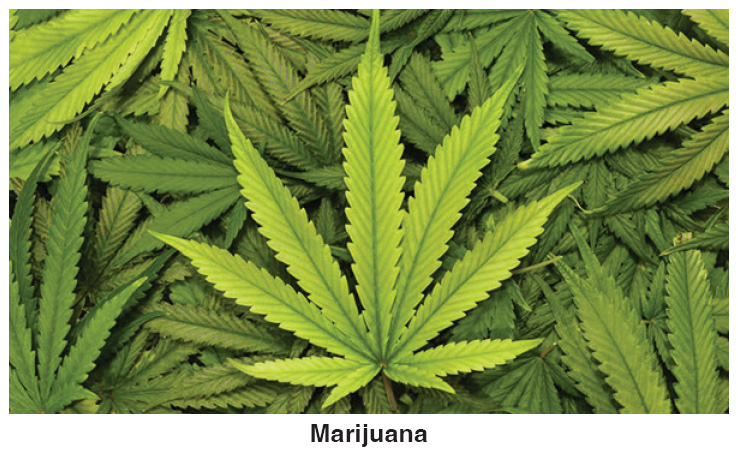 In Aldous Huxley's classic dystopian novel Brave New World,
published in 1932, the ruling class distributes a calming
recreational drug called "soma" to control society. One of the
main characters, Linda, uses the drug as it was most likely
intended, but she becomes addicted and it leads to her death.
In Aldous Huxley's classic dystopian novel Brave New World,
published in 1932, the ruling class distributes a calming
recreational drug called "soma" to control society. One of the
main characters, Linda, uses the drug as it was most likely
intended, but she becomes addicted and it leads to her death.
Marijuana has become such a drug in America today. Its dangerous effects in its current forms, especially on the youth, are being revealed by researchers. Recent studies suggest a strong connection between daily use of highly potent marijuana by adolescents and young adults, with addiction, depression, mental illness and changes in brain development affecting memory and reasoning skills.
As more evidence of the hazardous effects of marijuana use appears in scientific studies, politicians and the public continue to favour the legalisation of marijuana. In April this year, the Biden-Harris administration announced it was seeking to reclassify marijuana as a less dangerous drug. This historic shift in federal policy, away from the days of the 1930s when marijuana was equated with "Reefer Madness", would make it easier to sell marijuana and make the multibillion-dollar industry more profitable.
Pot is far more potent now
In late August, Republican presidential candidate Donald Trump
moved toward supporting a Florida ballot measure to legalise
"recreational" marijuana. "Whether people like it or not, this will
happen through the approval of the voters, so
it should be done correctly," Trump wrote on
Truth Social. "We need the state legislature
to responsibly create laws that prohibit the
use of it in public spaces, so we do not smell
marijuana everywhere we go, like we do
in many of the Democrat run Cities." On
September 8 he confirmed he will vote for
the ballot measure. Florida Governor Ron
DeSantis opposes the measure.
We need not believe that there is a Huxleyesque conspiracy to dumb down our populace to control it. What we do know is that today's marijuana is much, much more powerful. Vaping allows quick delivery to the brain. Daily use has serious behavioural consequences — and marijuana use has increased dramatically as it has become legal in more and more states. According to a Gallup survey, the number of Americans who have smoked marijuana has more than doubled since 2013.
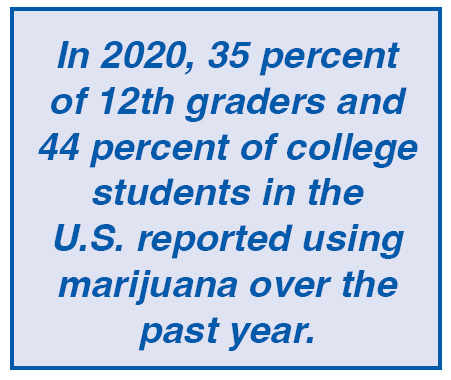 The percentage of Americans using marijuana is worrisome,
with 22 percent of people age 12 or older (61.9 million)
reporting that they did so in 2022. High-frequency cannabis use
is now more common than high-frequency drinking of alcohol
(17.7 million vs. 14.7 million daily or near-daily users). Another
survey conducted over a two-year interval from 2017 to 2019
showed that those reporting vaping marijuana over the preceding
30 days rose among high school students, nearly tripling among
high school seniors. In 2020, 35 percent of 12th graders and 44
percent of college students reported using marijuana over the
past year.
The percentage of Americans using marijuana is worrisome,
with 22 percent of people age 12 or older (61.9 million)
reporting that they did so in 2022. High-frequency cannabis use
is now more common than high-frequency drinking of alcohol
(17.7 million vs. 14.7 million daily or near-daily users). Another
survey conducted over a two-year interval from 2017 to 2019
showed that those reporting vaping marijuana over the preceding
30 days rose among high school students, nearly tripling among
high school seniors. In 2020, 35 percent of 12th graders and 44
percent of college students reported using marijuana over the
past year.
As of today, 24 states have legalised recreational marijuana, and 38 states and the District of Columbia have provided for medical use of marijuana. The widespread availability of marijuana is promoted as safe. How many times has one heard, "Marijuana is safer and less harmful than alcohol. If you want to get high, marijuana is better"? Or parents who, finding their child using marijuana, say, "I'm glad they're not on cocaine or heroin, which are really addictive."
In a feel-good age when ideally no person should feel unhappy, anxious, socially awkward or without self-esteem, marijuana appears to be a panacea. Why take a serotonin inhibitor like Prozac when marijuana is available? In fact, why not do both?
The marijuana being used today is not the same weed being used in the 1960s and 1970s. The potency of marijuana comes from THC (tetrahydrocannabinol), the psychoactive compound found in the plant. The THC found in today's selectively bred plants and extracts has steadily risen. Vaping marijuana drugs might have THC levels as high as 80 percent.
Even more potent are concentrated products that contain more than 90 percent THC. These concentrated products come in various forms and are small, easily concealed. The forms include crystal ("shatter"), buttering spread ("budder"), wax-like ("wax"), sugar-like ("sugar"), crumbly ("crumble"), a distillate ("distillate"), and chalky ("live rosin"). Teenagers especially like being in on knowing the names. These concentrates are produced in high-tech labs and then wrapped in slick, convenient, discreet packaging for use in electric devices.
The use among teenagers of highly potent marijuana in its various forms has increased. Those "dabbing", that is, using a concentrated product delivered through a heated device, more than doubled between 2015 and 2019. Although the Covid shutdowns decreased teenage usage, the percentage of teens using marijuana has again begun to creep back up.
Addiction, schizophrenia, dulling effects
About 1 in 10 people who use marijuana will become addicted,
according to the federal Substance Abuse and Health Services
Administration. When marijuana use started
before age 18, the rate of addiction rises to
1 in 6.
Dr Daniel Mamah, a psychiatrist and the director of the Washington Early Recognition Clinic at Washington University in St Louis, has observed in his clinical practice how serious psychiatric disorders are often associated with early and frequent marijuana use. Pointing to studies showing a link between early and frequent marijuana use and schizophrenia, he notes that young people who overuse marijuana "tend to have schizophrenia at increased rates, anywhere from two to four or five times as high a rate, depending on how much cannabis has been used". Moreover, marijuana dulls attention, memory and learning skills, and reaction time, movement and coordination, which can impair driving and athletic performance.
Neurological science has made great advances in the last two decades. This science is still in its infancy. The brain is an extremely complicated organ, but scientists are figuring out its basic hardware. Scientists know that the adolescent brain is developing and undergoing momentous changes until at least age 25.
During adolescent brain development, connectors are getting reinforced and being pruned. One of the key effects of marijuana on the brain is that THC binds to one of the brain's major receptors called CB1, which plays a major role in regulating anxiety, pain, memory and motivational behaviors. Studies in animals show that exposure to THC reduces CB1 in the brain. Research published in JAMA Psychiatry in 2021 suggests that cannabis use is associated with the thinning of teens' prefrontal cortex, which regulates emotions and problem-solving (executive) skills.
Depression, suicide, vomiting
Many medical studies report that recreational and heavy use of
cannabis is associated with depression, suicide and addiction
among adolescents. A report in published in the JAMA Network
Open in May 2024 found that adolescents who are unable to stop
using cannabis (medically known as "cannabis use disorder")
were between 2.5 and 3 times more likely to have depression or
suicidal thoughts than those who did not use cannabis.
Even worse, female youth aged 12 to 24 living in states with legalised medical or recreational marijuana between 2000 and 2019 had higher rates of death by suicide than youth in states with no such laws, with nearly 5,000 excess suicide deaths during that period, according to a report in the Journal of the American Academy of Child and Adolescent Psychiatry in March 2024.
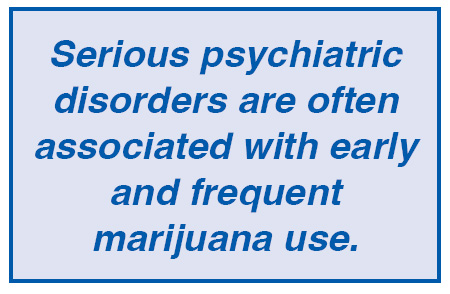 Another study that appeared in
JAMA Pediatrics in 2021 concluded
that those using cannabis as teenagers were more likely to
become addicted. Eleven percent of those between ages 12 to
17 progressed to cannabis use disorder within 12 months. After
three years, the prevalence was 20 percent of adolescents.
Another study that appeared in
JAMA Pediatrics in 2021 concluded
that those using cannabis as teenagers were more likely to
become addicted. Eleven percent of those between ages 12 to
17 progressed to cannabis use disorder within 12 months. After
three years, the prevalence was 20 percent of adolescents.
A Danish study of 6.9 million people aged 16 to 49 found an association between habitual cannabis use disorder and schizophrenia, as reported in the May 2024 issue of Psychological Medicine. The association was stronger for males overall. The researchers estimated that in 2021, up to 30 percent of schizophrenia diagnoses (about 3,000) could have been prevented if men aged 21 to 30 hadn't developed cannabis use disorder.
We know that some teenagers become highly dependent and dangerously physically ill while using marijuana. One of the consequences of habitual use among teenagers is called in scientific terms "cannabinoid hyperemesis syndrome", a condition that causes recurrent vomiting that can last hours.
The New York Times reported in 2022 on a girl named Elysee who first started vaping cannabis at the age of 14. She recalled that "It was insane. Insane euphoria". She turned to oil and waxes that she bought from dealers. Typically, these products were 90 percent THC. She began using it multiple times a day. Her parents found out about her use about a year later. Then she began having mysterious bouts where she would vomit over and over. In one two-hour period she threw up at least 20 times. Her doctors could not figure out what was causing the vomiting. After more than a half dozen trips to the emergency room and hospital stays, she was diagnosed with a condition that causes recurrent vomiting among heavy marijuana users. She finally got clean.
Other stories are more tragic. One mother in Colorado told the New York Times that she first found out about her son Johnny using marijuana when he was 14 years old. Her first reaction was, "Oh well, it's just weed. Thank God it was not cocaine."
She thought of marijuana as what she had tried a couple of times in high school. She told her son that marijuana was not good for him, but overall she was not terribly concerned about his use. "I used it, I'm fine, what's the big deal?" After all, Johnny was doing well in school and did not have any signs of mental health problems.
Delusions, paranoia, threats
Then things got worse. He started using high-potency marijuana
products multiple times a day. He became delusional. He was
placed in multiple treatment programs by the time he reached
college. In his first year in college, he became completely
delusional. He thought organised gangsters were after him andhis college was a base for the FBI. After he moved out of his
home, he threatened to kill the family dog unless his parents
gave him money. Then his mother discovered he had obtained
his own medical marijuana card, available to anyone over 18
under Colorado law. He began dealing to younger kids. He
had become a threat to his parents. Doctors prescribed an antipsychotic
medication, which seemed to help, until he stopped
taking it. In 2019, Johnny, once a promising boy with a good
future ahead of him before he began using marijuana, jumped
from a six-storey building. He was 19.
States that have legalised marijuana typically prohibit sales to minors. Nevertheless, anecdotes like those related above illustrate that minors can readily obtain cannabis, and it seems inevitable that legalisation will increase minors' access as a practical matter. Even now, very young children are ingesting THC through unregulated hemp-derived intoxicating "gummies", which resemble legal candy. "They are simply targeting children," Missouri Governor Mike Parson charged on September 10, calling for new laws to address the problem. "We need to put an end to it."
National poison control centres have stated that about two in five exposures to hemp-derived THC products are occurring in children. Julie Weber, director of the Missouri Poison Center, said the total number of poisoning cases linked to the products involving young children has doubled each year since 2018. "At the Missouri Poison Center, we have seen a steady increase in exposures related to accessibility and misidentification by children 5 years or younger consuming cannabis," Weber said.
 Horrific violence, spike in car crashes
Horrific violence, spike in car crashes
For a deep dive into the horrific violence that can result from
marijuana-induced psychosis, read Tell Your Children: The Truth
About Marijuana, Psychosis, and Violence (2019) by former
New York Times reporter Alex Berenson, who cites research
showing that "cannabis-dependent psychotic patients were four
times as likely to be violent".
He recounts true story after true story of inexplicable, unspeakably gruesome killings by people high on pot with no other known contributing factors, such as a California young woman audiologist with no criminal history who, following her first ingestion of marijuana, given to her by her accountant boyfriend, fatally stabbed him more than 100 times and then turned the knife on herself. Or a 35- year-old comic book artist and screenwriter who scalped his girlfriend, drained her body of blood, then hid in their condo with her corpse for more than a week.
The illegal alien who suddenly, savagely attacked Paul Pelosi, husband of the U.S. House Speaker, with a hammer in front of policemen in 2022 reportedly had a history of heavy pot use plus mental illness.
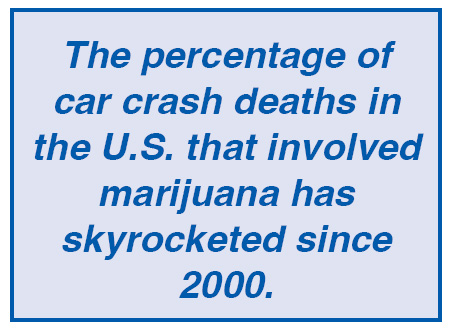 Another major threat from marijuana use is fatal car
crashes. A recent study published in the American Journal of
Public Health found that the percentage of car crash deaths in
the U.S. that involved marijuana has skyrocketed since 2000.
The percentage of car crash deaths involving cannabis alone
rose from 4.2 percent in 2000 to 11.2 percent in 2018. Over that
same period, the percentage of car crash deaths involving both
cannabis and alcohol rose from 4.8 to 10.3 percent. So the total
percentage of car crash deaths involving cannabis, either with
or without alcohol, rose to more than
a fifth of all car crash deaths in the
U.S. And this happened before the
general spike in car accidents that has
occurred since 2020, when political
considerations compelled police to
pull back on traffic enforcement.
Another major threat from marijuana use is fatal car
crashes. A recent study published in the American Journal of
Public Health found that the percentage of car crash deaths in
the U.S. that involved marijuana has skyrocketed since 2000.
The percentage of car crash deaths involving cannabis alone
rose from 4.2 percent in 2000 to 11.2 percent in 2018. Over that
same period, the percentage of car crash deaths involving both
cannabis and alcohol rose from 4.8 to 10.3 percent. So the total
percentage of car crash deaths involving cannabis, either with
or without alcohol, rose to more than
a fifth of all car crash deaths in the
U.S. And this happened before the
general spike in car accidents that has
occurred since 2020, when political
considerations compelled police to
pull back on traffic enforcement.
Monitoring the Future, a survey funded by the National Institute on Drug Abuse at the National Institutes of Health, found that the percentage of those aged 19 to 30 who use marijuana on a daily basis rose from 3.8 percent in 2000 to 7.8 percent in 2018 — more than doubling. That closely tracks the rise in car crash deaths involving marijuana over that period.
The latest evidence of risks of marijuana is a brand-new large study from the American Head and Neck Society, finding that cannabis use disorder may increase the risk of developing any head or neck cancer by 3.5 to 5 times.
The lure of freedom to choose
The campaign to legalise marijuana was
promoted by progressives and libertarians
— an odd coalition. Progressives sought to
turn out the youth vote by placing legalised
marijuana referendums on state ballots. For
libertarians, legalisation of marijuana was a
principle based on a belief that the state should not control our
bodies. Politicians saw new ways of bringing in revenue through
taxing marijuana dispensaries.
Many voters, young and old alike, agreed that marijuana should be legalised. Rhetoric that our prisons were full of people busted for holding a few ounces of marijuana became commonplace. This was not the case. Most prisoners committed serious crimes. Furthermore, those in prison for drug possession were often drug dealers who had been arrested for selling large quantities of drugs, but had taken plea deals admitting lesser crimes in order to reduce their sentences.
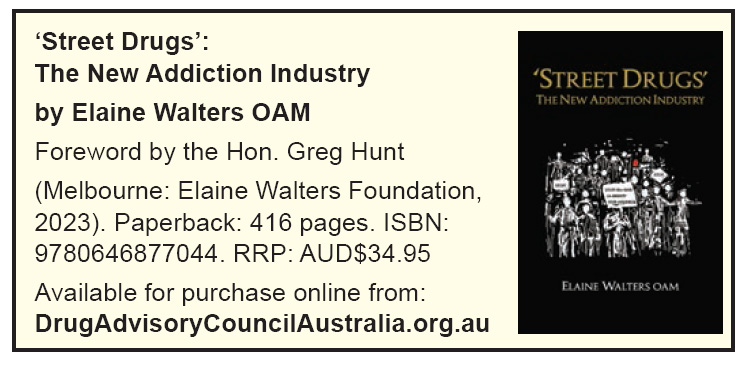 The marijuana industry is now big business. Any changes
in state marijuana laws will confront a powerful marijuana
lobby. It is unlikely that marijuana prohibition will be brought
back in states that have legalised weed, any more than alcohol
prohibition will be brought back. The cat is out of the bag. As
the perils of marijuana use come more and more to the public's
attention, maybe marijuana use will eventually go down — just
as it has for tobacco. We can hope, anyway.
The marijuana industry is now big business. Any changes
in state marijuana laws will confront a powerful marijuana
lobby. It is unlikely that marijuana prohibition will be brought
back in states that have legalised weed, any more than alcohol
prohibition will be brought back. The cat is out of the bag. As
the perils of marijuana use come more and more to the public's
attention, maybe marijuana use will eventually go down — just
as it has for tobacco. We can hope, anyway.
This article is published by the Cardinal Mindszenty Foundation in St Louis, Missouri, USA. The original article, complete with references and footnotes, is available from the foundation's website: www.mindszenty.org https.mindszenty.org. The Mindszenty Report is not copyrighted, and readers are invited to forward copies to their local bishops, priests and pastors.![]()
